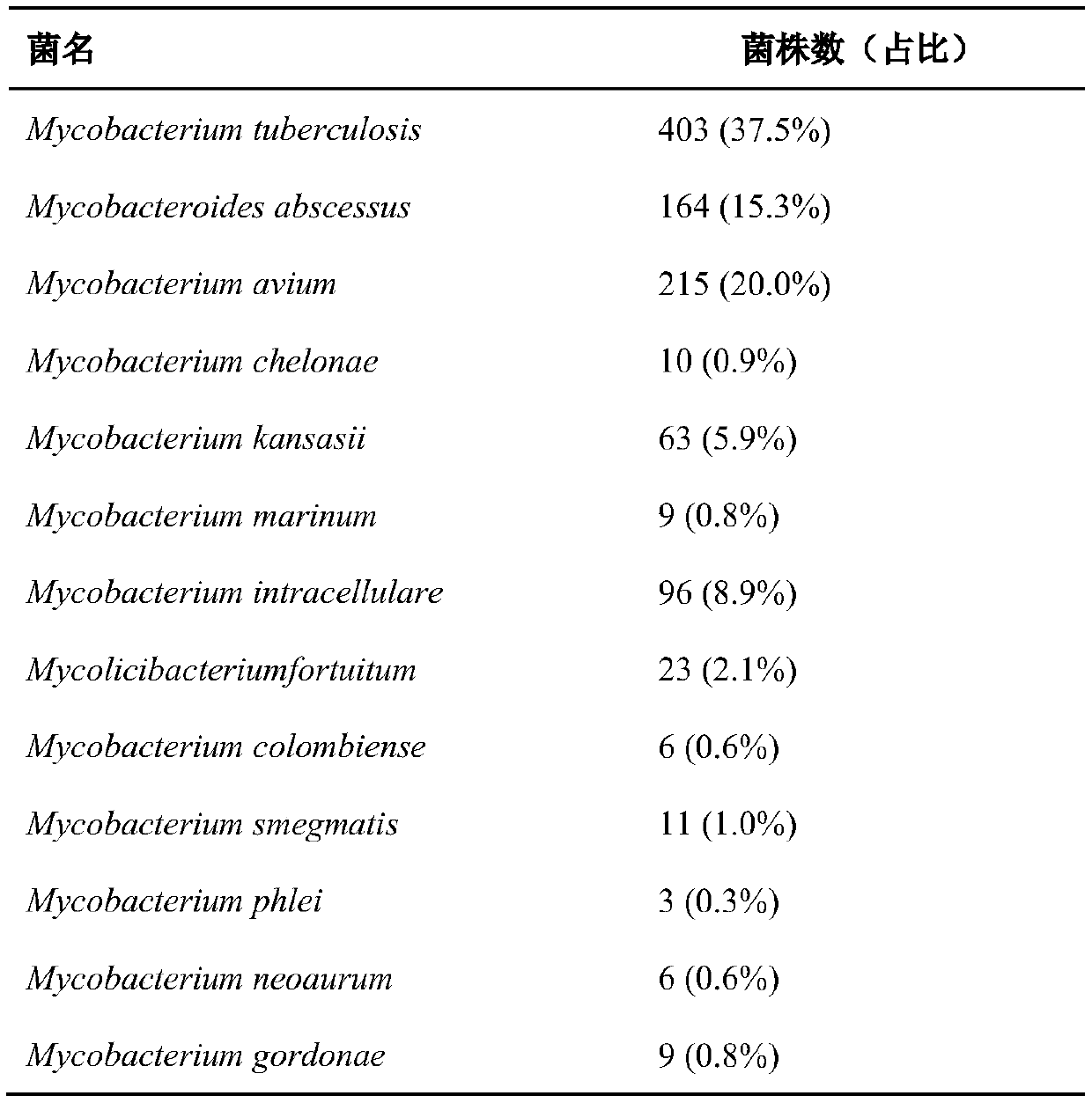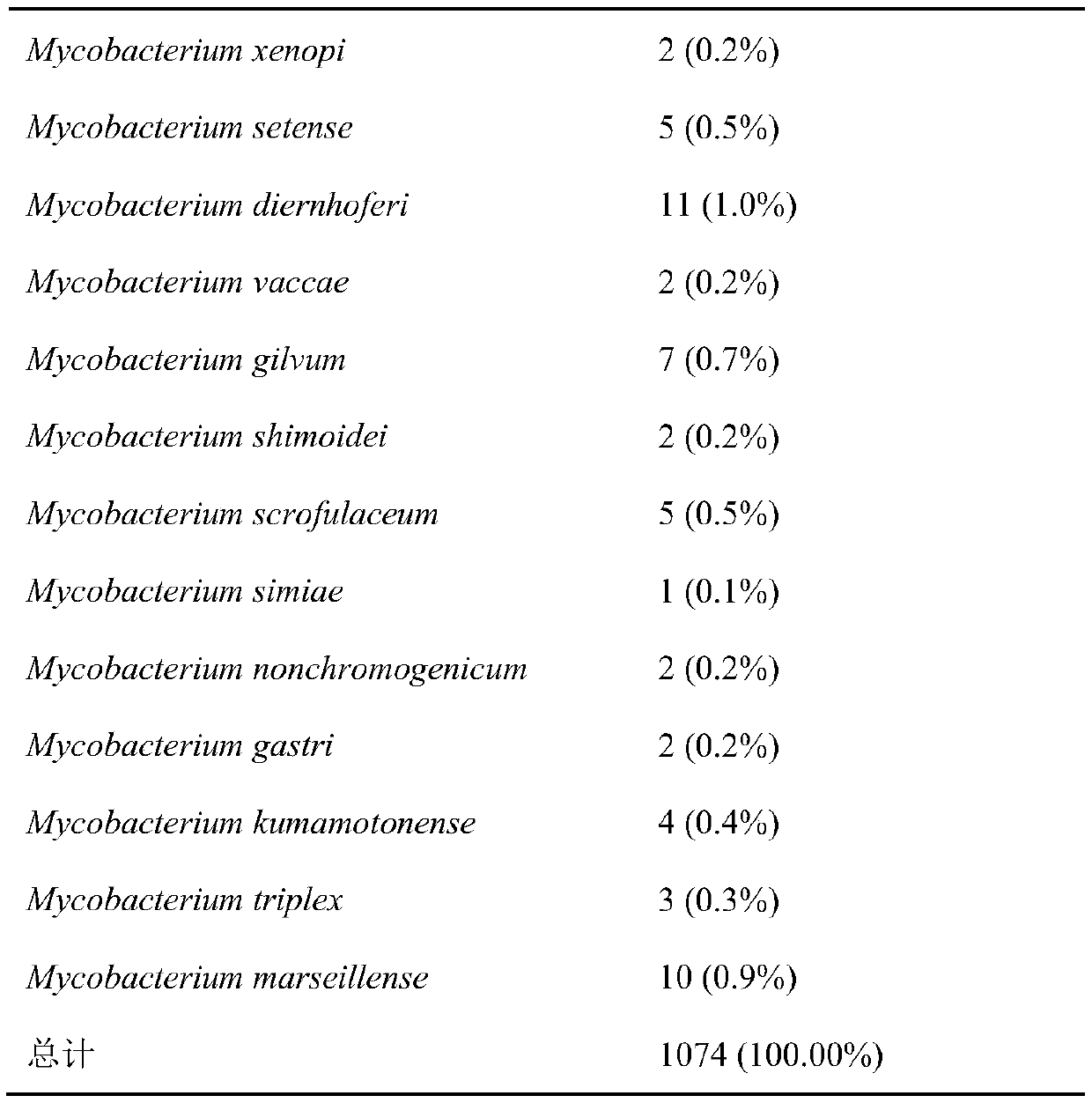A gene sequence composition and its application in the preparation of mycobacterial lung disease detection kit
A gene sequence, mycobacteria technology, applied in the field of molecular biology, can solve problems such as inability to distinguish MTB from NTM, delay in diagnosis, delay in patient condition, etc.
- Summary
- Abstract
- Description
- Claims
- Application Information
AI Technical Summary
Problems solved by technology
Method used
Image
Examples
Embodiment 1
[0019] 1) Determination of the type of bacteria:
[0020] The applicant collected 1074 strains of mycobacteria isolated from the lungs of patients with pulmonary infection in Shanghai Pulmonary Hospital from 2012 to 2016, covering a total of 26 species for target identification. The names of these 26 species and their presence in all The proportion of isolates is as follows:
[0021] Table 1 The species and composition of 1074 strains of mycobacteria isolated from Shanghai Pulmonary Hospital from 2012 to 2016
[0022]
[0023]
Embodiment 2
[0025] 1) Screening is used to identify the gene sequence composition of the above 26 kinds of mycobacteria:
[0026] The applicant performed whole-genome sequencing on the mycobacteria in Table 1. According to the whole-genome sequencing results, combined with the whole-genome data of some mycobacteria (total 390 strains) published by the public database NCBI (Table 2), the applicant initially established the The decision tree model for identifying various bacterial species at the genome level. Based on the model algorithm, 27 genes (shown in SEQ ID NO.1 to SEQ ID NO.27) were found to be specific to bacterial species. The different combinations of these 27 gene sequences Rapidly distinguish Mycobacterium tuberculosis (MTB) from non-tuberculous mycobacteria (NTM), and further identify non-tuberculous mycobacteria into species (including 1074 strains of mycobacteria clinically isolated by the applicant and published by NCBI 390 strains of mycobacteria), the results of gene sequ...
Embodiment 3
[0040] Application of the gene sequence composition in detecting mycobacteria:
[0041] Based on the gene sequence composition screened in Example 2, the applicant further expanded the sample size and downloaded the whole genome data of all mycobacteria currently disclosed, a total of 7888 strains, for testing the accuracy of the gene sequence composition of the present invention .
[0042] The 27 gene sequences provided by the present invention were compared with the whole genome sequences of the selected 7888 strains, and the presence or absence of the genes was recorded.
[0043]The results show that the gene sequence composition provided by the present invention has a high identification accuracy rate of 97%-100% for 26 kinds (7888 strains) of mycobacteria (Table 3), which shows that the gene sequence composition provided by the present invention has a significant effect on the identification of the bacterium. The mycobacterium species has a strong resolution, and can be ...
PUM
 Login to View More
Login to View More Abstract
Description
Claims
Application Information
 Login to View More
Login to View More - R&D
- Intellectual Property
- Life Sciences
- Materials
- Tech Scout
- Unparalleled Data Quality
- Higher Quality Content
- 60% Fewer Hallucinations
Browse by: Latest US Patents, China's latest patents, Technical Efficacy Thesaurus, Application Domain, Technology Topic, Popular Technical Reports.
© 2025 PatSnap. All rights reserved.Legal|Privacy policy|Modern Slavery Act Transparency Statement|Sitemap|About US| Contact US: help@patsnap.com



